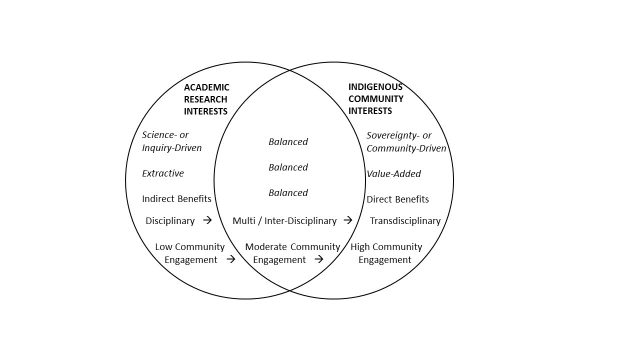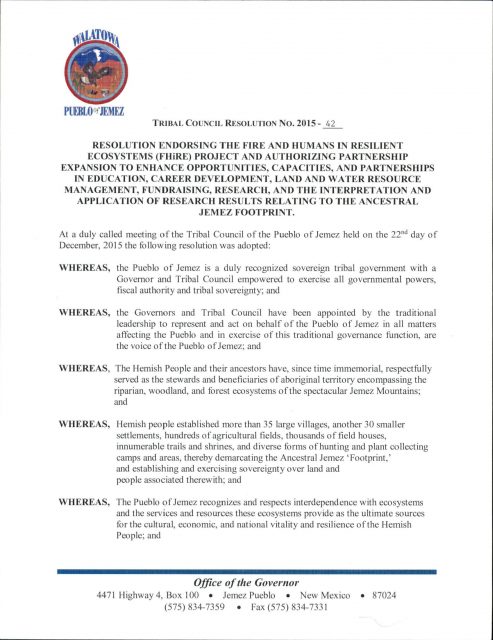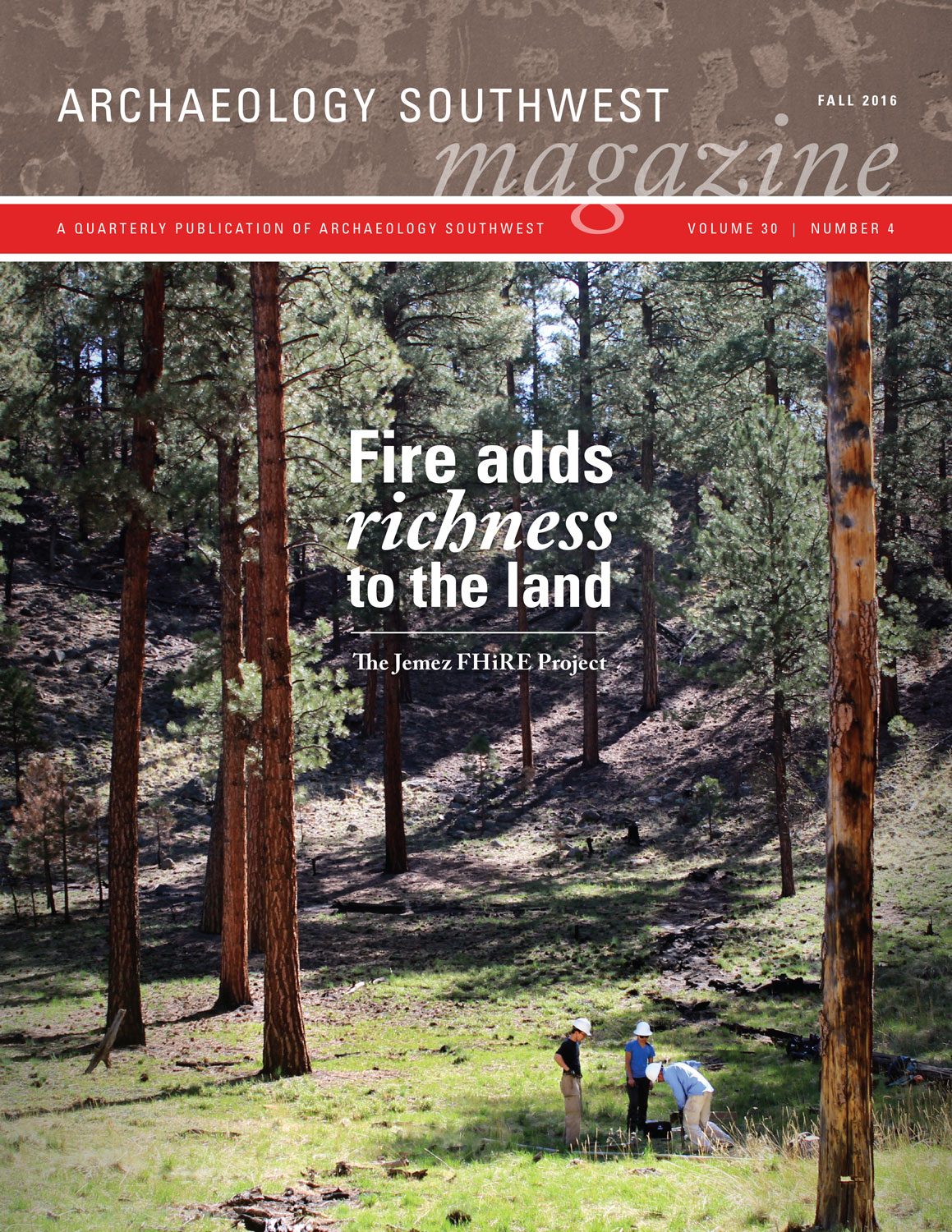Description
In this issue:
The Jemez FHiRE Project: An Introduction— Christopher I. Roos and Thomas W. Swetnam
Fire Adds Richness to the Land: Ethnographic Knowledge about Forests and Fire—Benrita “Mae” Burnette, Ronnie Cachini, T. J. Ferguson, Sharlot Hart, Stewart B. Koyiyumptewa, Octavius Seowtewa, Paul Tosa, John R. Welch
The Hemish Footprint—Paul Tosa and Barry Price Steinbrecher
Jemez Archaeology and History—Matthew Liebmann and
Chris Toya
The High-Elevation Archaeological Record of the Valles Caldera—Anastasia Steffen
Terminus Ante Quem Dating of the Depopulation of Jemez Ancestral Villages—Josh Farella and Thomas W. Swetnam
Modeling Jemez Population—Matthew Liebmann
Through Fire and Water: Ancestral Jemez Water Management—Michael Aiuvalasit
Tree-Ring Records of Forests, People, and Fire in the Jemez Mountains—Thomas W. Swetnam
The Long-Term Context for Human–Fire Relationships on the Jemez Plateau—Christopher I. Roos
Modeling Ancient Land Use and Resilient Forests in the Jemez Mountains—Rachel Loehman
Lessons from Four Centuries of Local Management for Contemporary Fire Challenges—Thomas W. Swetnam and Christopher I. Roos
FHiRE Outreach: Learning about Forest Fires Then and Now—Sara Chavarria
Beyond Community Consent: Toward Sovereignty-Driven Academic Research—Francis Vigil and John R. Welch
Back Sight—William H. Doelle
Archaeology Southwest Magazine Vol. 30, No. 4
Issue editors: Christopher I. Roos (Southern Methodist University) and T. J. Ferguson (University of Arizona)
The Jemez FHiRE (Fire & Humans in Resilient Ecosystems) Project examines the human and environmental histories of the Jemez Plateau in light of traditional tribal knowledge about living in forested areas of the U.S. Southwest, and with an eye toward contemporary fire management issues at the Wildland–Urban Interface.
For further reading: Many of the authors’ names below are linked to their scholarly web pages. Those pages show or link to bibliographies related to the research presented in this issue. Any references specifically called out in an article are given below.
The Jemez FHiRE Project: An Introduction — Christopher I. Roos and Thomas W. Swetnam
National Science Foundation GEO-1114898
Summaries of papers presented at the 2015 Society for American Archaeology Conferences on tDAR
What is the Wildland-Urban Interface? (Ready, Set, Go! Program)
Fire Adds Richness to the Land: Ethnographic Knowledge about Forests and Fire — Benrita “Mae” Burnette, Ronnie Cachini, T. J. Ferguson, Sharlot Hart, Stewart B. Koyiyumptewa, Octavius Seowtewa, Paul Tosa, and John R. Welch
Hopi Tribe
Pueblo of Jemez
Pueblo of Zuni
White Mountain Apache Tribe
The Hemish Footprint — Paul Tosa and Barry Price Steinbrecher
Walatowa Vistor Center (Jemez Pueblo)
Price Steinbrecher, Barry
2015 The Geography of Heritage: Comparing Archaeological Culture Areas and Contemporary Cultural Landscapes. Master’s thesis, University of Arizona.
Jemez Archaeology and History — Matthew Liebmann and Chris Toya
Liebmann, Matthew
2012 Revolt: An Archaeological History of Pueblo Resistance and Revitalization in 17th-Century New Mexico. University of Arizona Press, Tucson.
The High-Elevation Archaeological Record of the Valles Caldera — Anastasia Steffen
Valles Caldera National Preserve
Parmenter, Robert R., Anastasia Steffen, and Craig D. Allen
2007 An Overview of the Valles Caldera National Preserve: The Natural and Cultural Resources. New Mexico Geological Society Guidebook, 58th Field Conference, Geology of the Jemez Mountains Region II, pp. 147–154. (opens as a PDF)
Terminus Ante Quem Dating of the Depopulation of Jemez Ancestral Villages — Josh Farella and Thomas W. Swetnam
“Terminus ante quem” at Archaeology Wordsmith
Farella, Joshua
2015 Terminus Ante Quem Constraint of Pueblo Occupation Periods in the Jemez Province, New Mexico. Master’s thesis, University of Arizona.
Modeling Jemez Population — Matthew Liebmann
Liebmann, Matthew J., Joshua Farella, Christopher I. Roos, Adam Stack, Sarah Martini, and Thomas W. Swetnam
2015 Native American depopulation, reforestation, and fire regimes in the Southwest United States, 1492–1900 CE. Proceedings of the National Academy of Sciences Vol. 113, No. 6.
Antonio de Espejo
Fray Gerónimo Zárate Salmerón
Fray Augustín de Vetancurt
Alonso de Benavides
Diego de Vargas
Through Fire and Water: Ancestral Jemez Water Management — Michael Aiuvalasit
Matt Peeples’s map of Pueblo languages and sub-groups (Tewa, Towa, Keres, and others; opens as a PDF)
Tree-Ring Records of Forests, People, and Fire in the Jemez Mountains — Thomas W. Swetnam
The Laboratory of Tree-Ring Research: About Tree Rings
Swetnam, Thomas W., Joshua Farella, Christopher I. Roos, Matthew J. Liebmann, Donald A. Falk, and Craig D. Allen
2016 Multiscale perspectives of fire, climate and humans in western North America and the Jemez Mountains, USA. Philosophical Transactions of the Royal Society B 371(1696).
The Long-Term Context for Human–Fire Relationships on the Jemez Plateau — Christopher I. Roos
Modeling Ancient Land Use and Resilient Forests in the Jemez Mountains — Rachel Loehman
About FireBGCv2
Lessons from Four Centuries of Local Management for Contemporary Fire Challenges — Thomas W. Swetnam and Christopher I. Roos
FHiRE Outreach: Learning about Forest Fires Then and Now — Sara Chavarria
The results of our collaboration were several tools that we hope help more teachers and students understand forest fires today:
Beyond Community Consent: Toward Sovereignty-Driven Academic Research — Francis Vigil and John R. Welch


Back Sight — William H. Doelle
Archaeology Southwest Magazine 28-3 & 4, Tortuous and Fantastic: Cultural and Natural Wonders of Cedar Mesa
Bears Ears Inter-Tribal Coalition
Utah Diné Bikeyah
Friends of Cedar Mesa
Great Bend of the Gila National Monument
Subscribe


